Story by John Vonderlin
Email John ([email protected])
Story by John Vonderlin
Email John ([email protected])
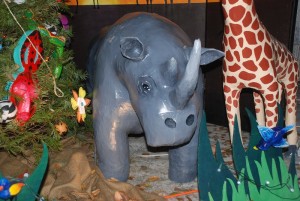 To enjoy more of Joel Bratman’s Christmas images please click here
To enjoy more of Joel Bratman’s Christmas images please click here
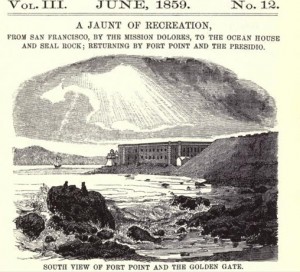
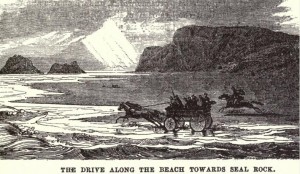
I’ve got a lot of background material on the charismatic Mr. Hutchings and his Magazines, I’ll send next. Wikipedia has articles on both, with links to other online sources for the magazines beside archive.org. He was Mr. Yosemite. The picture placement is only approximate. Enjoy. John
Hi June,
This is Mr. Hutchings’, “Farallone Islands,” article. It appeared in the second issue of his first volume of the “California Illustrated Magazine,” in August, 1856. Enjoy. John


Caption: SOUTH-EAST VIEW OF THE FARALLONE ISLANDS
THE FARALLONE ISLANDS.

This is the name of a small group of rocky islands, lying in the Pacific Ocean, about twenty-seven miles west of the Golden Gate, and thirty-five miles from San Francisco.
These islands have become of some importance, and of considerable interest, on account of the vast quantity of eggs that are there annually gathered, for the California market; these eggs having become an almost indispensable article of spring and summer consumption, to many persons.
By the courtesy of the Farallone Egg Company, through their President, Captain Richardson, the schooner Louise, Captain Harlow, was placed at our service, for the purpose of visiting them; and, in company with a small party of friends, we were soon upon the deep green brine, plowing our way to these ” Isles of the Ocean.”
To the dwellers of an inland city, there is music in the ever restless waves, as they murmur and break upon the shore ; but, to sail upon the broad heaving bosom of the ocean, gives an impression of profoundness and majesty that, by contrast, becomes a source of peaceful pleasure; as change becomes rest to the weary. There is a vastness,around, above, beneath you, as wave after wave, and swell after swell, lifts your tiny vessel upon its seething surface, as though it were a feather, a floating atom upon the broad expanse of waters. Then, to look into its shadowy depth, and feel the sublime language of the Psalmist : Lord, how manifold are thy works,! in wisdom hast Thou made them all: the earth is full of thy riches. So is this great and wide sea, wherein are things creeping innumerable, both small and great beasts. There go the ships. There is that leviathan, whom Thou hast made to play therein.
These wait all upon Thee : that Thou mayest give them their meat in due season. Thou openest thy hand, they are filled with good. Thou hidest thy face, they are troubled.
“Yonder blows a whale!” cries one.
“Where?”
“Just off our larboard bow”
Oh! I see it but…”
But,! what ‘s the matter?”
Oh! I feel so seasick”
Caption: ENCHANTED WITH THE DELIGHTFUL PROSPECT OFF THE BAR
“Well, never mind that; look up, and
don’t think about it”
“Oh I can’t, I must ”
Reader, were you ever seasick? If your experience enables you to answer in the affirmative, you will sympathize somewhat with the poor subject of it. Yonder may be this beauty, and that wonder, but a don’t-careishness comes over you, and if all the remarkable scenes in creation were just before you,I don’t care is written upon the face, as you beseechingly seem to say : Pray don’t trouble me, my hands are full.” “Whales, sea gulls, porpoises, and even the white, foamy spray, that is curling over Duxbury Reef, are alike unheeded.
“How are you now ?” kindly asked our good natured Captain, of the one and the other.
” Ah ! thank you ; I am better.”
” Here, take a cup of nice hot coffee.”
” No ; I thank you.”
The mere mention of anything to eat or to drink is only the signal for a renewal of the sickness.
“Thank goodness! I feel better,” says one, after a long spell of sickness and quiet.
” So do I,” says another ; and, just as the ” Farallones ” are in sight, fortunately, all are better.
Now the air is literally filled with birds birds floating above us, and birds all around us, like bees that are swarming ; we thought the whole group of islands must have been deserted, and that they had
poured down in myriads, on purpose to intercept our landing, or “bluff us off;” but, as the dark weather beaten furrows, and the wave washed chasms, and the wind swept masses of rock, rose more defined and distinct before us, as we approached, we concluded that they must have abandoned the undertaking for upon every peak sat a bird, and in every hollow a thousand ; but, looking around us again, the number, apparently, had increased, rather than diminished ; and, the more there seemed to be upon the islands, the greater the increase round about us so that we concluded ourfears to be entirely unfounded ! The anchor is dropped in a mass of floating foam, on the southeast, and sheltered side of the islands, and, in a small boat, we reach the shore ; thankful, after this short
voyage to feel our feet standing firmly on terra firma.
Looking at the wonders on every side,we were astonished that we had heard so little about them ; and, that a group of islands like these, should lie within a few hours
sail of San Francisco, yet not be the resort of nearly every seeker of pleasure, and every lover of the wonderful.
It is like one vast menagerie. Upon the rocks adjacent to the sea, repose in easy indifference, thousands yes, thousands of sea lions (one species of the seal,) that weigh from two to five thousand pounds each”
As these made the loudest noise, and to us were the most curious, we paid them the first visit. When we were within a few yards of them, the majority took to the water, while two or three of the oldest and largest remained upon the rock, standing guard over the young calves, that were either at play with each other, or asleep at their side. As we advanced, these masses of ” blubber ” moved slowly and clumsily towards us, with their mouths open, and showing two large tusks, that were standing out from their lower jaw, by which they gave us to understand that we had better not disturb the repose of thw juvenile lions,” nor approach too near ; or, we might receive more harm than we intended, or wished. But the moment we threw at them a stone, they would scamper off and leave the young lions to the mercy of their enemies.
[more to come]
Half Moon Bay’s Claudia Marshall 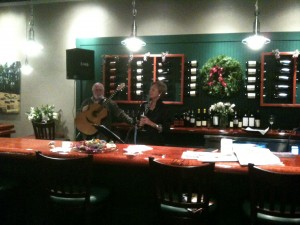 seen here with Miramar musician/songwriter Mo Robinson, welcomed guests to the opening of her new Wine Bar next door to Harbor Books in the
seen here with Miramar musician/songwriter Mo Robinson, welcomed guests to the opening of her new Wine Bar next door to Harbor Books in the 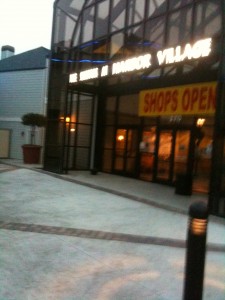 Harbor Village Shopping Center, Princeton-By-The-Sea.
Harbor Village Shopping Center, Princeton-By-The-Sea.
A nice crowd arrived to do some wine tasting of mostly reds, but I loved this delicious Sauvignon Blanc 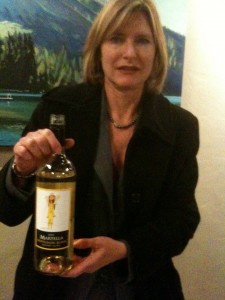 produced by Martella Winery.
produced by Martella Winery.
When I arrived, guitarist Mo Robinson was playing a tune he wrote called “Pescadero,” the first place, he told me that he lived at when he moved to the Coastside. The walls of the spacious Wine Bar are home to artist Jim Caldwell’s 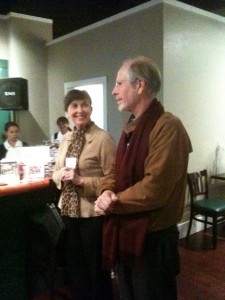 oil paintings of our California landscapes.
oil paintings of our California landscapes.
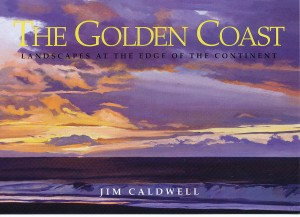
————————–
“Rainbow Pier” image by Michael Wong

Photographer Deb Wong says: Last week, Mike got a nice shot next to the Pacifica pier, where the waves brought up rainbows. I took video of it, but it didn’t show up. However, Mike had the camera set just right to capture the rays & waves in one shot (see attached). Heard they are calling it off for tomorrow….stay tuned…
Thalassophilia

“The sea is calm tonight”, Matthew Arnold’s poem “Dover Beach” begins, with the ocean setting the background for an impassioned plea: “Let us be true to one another.”
The ocean is the background for many Coastsiders besides the fishermen, the surfers and the beachcombers. We are so used to its sound, its constant presence, that sometimes we hardly notice it unless it rushes under the front door at Nick’s Restaurant in Pacifica, throws foam on the highway, or produces monster waves like the ones the Maverick’s people are expecting next week.
I have been a Thalassophile, an ocean lover, since I first saw the sea when I was fifteen. Born in Tennessee, I knew about lakes and rivers, but I was stunned speechless when I first saw the vastness of the Atlantic Ocean from the Carolina coast.
Since then, I have crossed the Atlantic by ship and plane any number of times, have been swimming in the Mediterranean, the Aegean and the Ionian seas, but I have settled at last where the first and last sights of daylight are the waves hitting the foot of Montara Mountain. The sound of the surf lulls me to sleep every night.
“Another summer at sea?” my husband remarked mildly last June as I began my fourth trip through Patrick O’Brian’s 21 seafaring Aubrey-Maturin books.
Now I am reading Herman Melville’s Moby Dick for the first time and wondering why this big novel always seemed so daunting, gathering dust on the bookshelf all these years.
I am editing Susan Bradfield’s book The Reluctant Sailor, using Google Docs, since she is living on the yacht Apple II in Baja after some truly harrowing adventures in the Pacific. (Her first book, Any Time, Any Place: Meditation for Your Earthwalk, is now available on Kindle.)
My neighbor Richard is a true Thalassophile. He can see the Pacific from almost every room in his house. He fishes, walks his dogs on the beach, calls our ocean “Mother Pacific.” When he and Dolores were married at home, I took my portable keyboard and played Antonio Carlos Jobim’s “Wave”. We ate crab and drank champagne, just them and the minister and me.
Everything rusts, silver will discolor overnight; we have fog and mildew and bone-chilling summers, but I don’t think I’d ever want to live out of sight and sound of our Pacific.
June,
I flipped my Zodiac (inflatable boat-with a 40 h.p. motor) surfing waves at Mavericks, years ago, before it became famous.
………..Collin
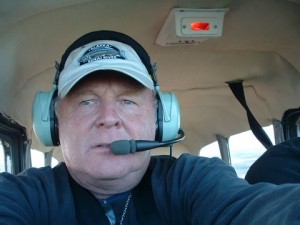
Story by June Morrall
[Image of Jeff Clark by Jerry Koontz]
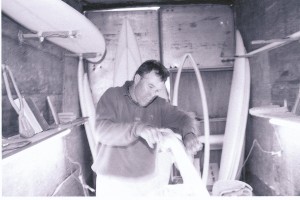
As I was working on my Princeton-By-The-Sea book a couple of years ago I interviewed Coastside surfer Jeff Clark, the “face” of Mavericks.
I’m a bit older than Jeff and I remember him as a teenager living with his family in Miramar Beach behind the geodesic dome and A-frame with the concrete angel on top that belongs to photographer and adventurer Michael Powers. At the time, though, it was the 1970s, the dome and A-frame had not been completed and Michael was living in the original house that stood on the property next door to Medio Creek. It eventually burned making way for the more fun stuff.
The Clark family lived in a newer two story home behind Michael Power’s and that’s where I had my first glimpses of young Jeff Clark wearing a wet suit, surfboard in hand. There would be us, the hanger-outters at Michael’s unique place, always active, maybe helping to build the dome, but always doing something because Michael would have it no other way– and then out of the corner of my eye I would see the fast moving image of blonde Jeff Clark. There, and then, poof, gone to catch the waves.
That was also the time when, not far from the Powers and the Clarks, the Film School had set up shop, shooting the local scenery, and offering classes to aspiring filmmakers. As I recall, there was a lot of running through the fields….
Jeff told me he first visited cozy Miramar Beach as a youngster in 1963. He came with his grandfather and there wasn’t much there except for a few houses, including farmhouses, Spouters (the present day site of the Miramar Beach Inn), Pete Douglas’s Ebb Tide Cafe/Bach Dancing & Dynamite Society, and Albert’s, which during the Ocean Shore Railroad era was home to the stunning Palace Miramar Hotel, equipped with a salt water plunge. Decades later Albert’s was named for its owner in the 1960s, Albert Schmidt, and he and wife Eva ran it as a restaurant and bar overlooking the then prolific sand dunes –and a former early 20th century wharf that was rapidly disintegrating. For the locals it was great sport to enjoy a drink at Albert’s at sun-setting time and make bets on when the last pier piling would vanish forever. Albert’s, one of the last reminders of Miramar Beach’s historic past, burned about 1966.
Three years later the Clark family moved to Miramar Beach where they replaced a farmhouse and water tower with a new home.
In the late 1960s and early 70s the places to surf were at Miramar, Martin’s Beach (south of Half Moon Bay) and “the jetty” at El Granada, also called “Surfer’s Beach.”
“The jetty,” said Jeff Clark, “was the only wave-protected area, inside the rocks.” In the 1970s Ano Nuevo, south of Pescadero, became a decent destination.
But Clark did not know Mavericks until 1968 or 69. He added that in the early 1960s it wasn’t home to the big wave spot it is today; on the contrary, the waves were much smaller than today’s 70 foot waves which have brought great fame to Mavericks.
[Locals often surfed Mavericks, a place they knew as “the Point.” In the early days you could drive out there and leave your car in a large parking lot. One of the most famous surfers was Walt Von Hauffe, who owned Von’s Cinema which was located in the town of Half Moon Bay.]
Jeff Clark’s love of the waves naturally grew into the business of fashioning custom surfboards for every kind of wave, small or big, in the world. He began making boards in 1981, in the old Henry Doelger Mill Building in Princeton, the building where wood had originally been processed for home construction in the 1950s. Like all good artists, he has “the eye,” and the patience to make hand-shaped, tailor fit boards.
Remember, it was two or more years ago when I talked to Jeff about the Mavericks Surf Contest, and he was very involved in organizing the spontaneous event that takes place some time between November and March. He talked about tracking the weather, waiting for the big waves to show up (he can see the waves breaking from his living room couch) and calling up 24 surfers, many from Hawaii and Southern California for the one day event. (For variety, every year ten new surfers are added to the list.) They have 24-36 hours to make the date.
The giant wave that is Mavericks is located a half-mile off shore. That means the surfers are transported on jet ski boats to ride the slippery slope off Pillar Point, a magnificent slice of land that juts into the blue gray Pacific.
The storms are here and there’s a lot of big wave talk around Half Moon Bay. Before the rain began, my cousin and I took a long walk this morning, out to Mavericks, and then on the cliffs above, we looked toward Pillar Point and the sea, wondering if the time was going to be right for the perfect 70 foot waves.
Let the contest begin!
—————-
Jeff Clark told me Mavericks was not named for his dog. Long ago, he said, before the place became famous, he heard a fellow riding a longboard called it “Mavericks.”